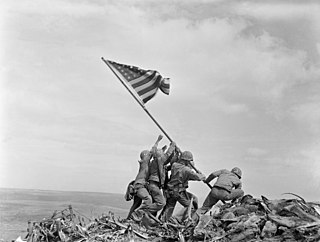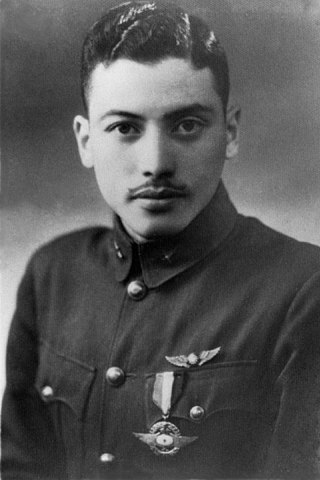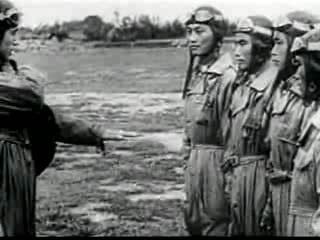Sino-Japanese War most often refers to:

The Second Sino-Japanese War was fought between the Republic of China and the Empire of Japan between 1937 and 1945, following a period of war localized to Manchuria that started in 1931. It is considered part of World War II, and often regarded as the beginning of World War II in Asia. It was the largest Asian war in the 20th century and has been described as "the Asian Holocaust", in reference to the scale of Japanese war crimes against Chinese civilians. It is known in China as the War of Resistance against Japanese Aggression.

The Pacific War, sometimes called the Asia–Pacific War or the Pacific Theater, was the theater of World War II that was fought in eastern Asia, the Pacific Ocean, the Indian Ocean, and Oceania. It was geographically the largest theater of the war, including the Pacific Ocean theater, the South West Pacific theater, the Second Sino-Japanese War, and the Soviet–Japanese War in the last few months of the war.

The Battle of Shanghai was a major battle fought between the Empire of Japan and the Republic of China in the Chinese city of Shanghai during the Second Sino-Japanese War. It lasted from August 13, 1937, to November 26, 1937, and was arguably the single largest and longest battle of the entire war, with it even regarded by some historians as the first battle of World War II. It resulted in the Japanese capture of the city and heavy destruction to the city.

The Imperial Japanese Navy Air Service (IJNAS) was the air arm of the Imperial Japanese Navy (IJN). The organization was responsible for the operation of naval aircraft and the conduct of aerial warfare in the Pacific War.

Arthur Tien Chin was a pilot from the United States who participated in the Second Sino-Japanese War. Chin was compelled to defend his father's homeland when Japan invaded China. He was part of the first group of U.S. volunteer combat aviators. Chin is recognized as the United States' first flying ace in World War II.

The January 28 incident or Shanghai incident was a conflict between the Republic of China and the Empire of Japan. It took place in the Shanghai International Settlement which was under international control. Japanese army officers, defying higher authorities, had provoked anti-Japanese demonstrations in the International Settlement following the Japanese invasion of Manchuria. On January 18th, five Japanese Buddhists in Shanghai belonging to the Nichiren sect allegedly shouted anti-Chinese, pro-Japanese nationalist slogans in Shanghai. In response, a Chinese mob formed killing one monk and injuring two. In response, the Japanese in Shanghai rioted and burned down a factory, killing two Chinese. Heavy fighting broke out, and China appealed to the League of Nations. A truce was finally reached on May 5, calling for Japanese military withdrawal, and an end to Chinese boycotts of Japanese products. It is seen as the first example of a modern war waged in a large city between two heavily equipped armies and as a preview of what was to come during the Second World War.

The bombing of Chongqing, from 18 February 1938 to 19 December 1944, was a series of massive terror bombing operations authorized by the Empire of Japan's Imperial General Headquarters and conducted by the Imperial Japanese Army Air Service (IJAAF) and Imperial Japanese Navy Air Service (IJNAF). Resistance was put up by the Chinese Air Force and the National Revolutionary Army's anti-aircraft artillery units in defense of the provisional wartime capital of Chongqing and other targets in Sichuan.

Chengdu Shuangliu International Airport is one of two international airports serving Chengdu, the capital of Sichuan province in Southwestern China. Built in 1938 and expanded for eight times, it is one of the oldest airports in China. The airport became the third-busiest airport in the world in 2020.

The Chinese Nationalist Air Force or simply The Republic of China Air Force was the Air Force formed by the Kuomintang (KMT) after the establishment of the Aviation Ministry in 1920. As tensions mounted between China and Imperial Japan in the 1930s, air units from the Chinese warlords, including those from the Guangdong Provincial Air Force, and overseas Chinese aviators, became integrated into the centralized command of the ROCAF and coordinating with the Second United Front to counter the Imperial Japanese invasion and occupation.

The Second Sino-Japanese War began on 7 July 1937 with the Marco Polo Bridge incident in the Republic of China and is often regarded as the start of World War II as full-scale warfare erupted with the Battle of Shanghai, and ending when the Empire of Japan surrendered to the Allies in August 1945. The Chinese Air Force faced the Imperial Japanese Army and Navy Air Forces and engaged them in many aerial interceptions, including the interception of massed terror-bombing strikes on civilian targets, attacking on each other's ground forces and military assets in all manners of air interdiction and close air support; these battles in the Chinese skies were the largest air battles fought since World War I, and featured the first-ever extensive and prolonged deployment of aircraft carrier fleets launching preemptive strikes in support of expeditionary and occupation forces, and demonstrated the technological shift from the latest biplane fighter designs to the modern monoplane fighter designs on both sides of the conflict.

The Canton Operation was part of a campaign by Japan during the Second Sino-Japanese War to blockade China to prevent it from communicating with the outside world and importing needed arms and materials. Control of Guangzhou (Canton) and the Pearl River Delta would provide a base to make the blockade of Guangdong province more effective by seizing southern China's major port and isolate the British port of British Hong Kong.

The Curtiss BF2C Goshawk was a United States 1930s naval biplane aircraft that saw limited success and was part of a long line of Hawk Series airplanes made by the Curtiss Aeroplane and Motor Company for the American military, and for export as the Model 68 Hawk III.

The Taihoku Air Raid was the largest Allied air raid on the city of Taihoku, then under Japanese colonial rule, during World War II. Many residents were killed in the raid and tens of thousands wounded or displaced.

Xi'an Xiguan Airport was an airport that served Xi'an, capital of Northwest China's Shaanxi province. It was the city's main airport until it was replaced by the newly opened Xi'an Xianyang International Airport on 1 September 1991.
Liangping Airport, also called Liangshan Airport, is a former dual-use military and civil airport, located north of Liangping District in Chongqing Municipality, China. It served the city of Wanxian from July 1988 until May 2003, when all civil flights were transferred to the new Wanzhou Wuqiao Airport.

Air warfare was a major component in all theaters of World War II and, together with anti-aircraft warfare, consumed a large fraction of the industrial output of the major powers. Germany and Japan depended on air forces that were closely integrated with land and naval forces; the Axis powers downplayed the advantage of fleets of strategic bombers and were late in appreciating the need to defend against Allied strategic bombing. By contrast, Britain and the United States took an approach that greatly emphasized strategic bombing and tactical control of the battlefield by air as well as adequate air defenses. Both Britain and the U.S. built substantially larger strategic forces of large, long-range bombers. Simultaneously, they built tactical air forces that could win air superiority over the battlefields, thereby giving vital assistance to ground troops. The U.S. Navy and Royal Navy also built a powerful naval-air component based on aircraft carriers, as did the Imperial Japanese Navy; these played the central role in the war at sea.
Jurong Airfield, may also be romanized as Chuyung (Cantonese), was an air force base serving in defense of former capital city of Nanjing during the Republic of China era on the mainland.
Huang Panyang was a Chinese-American aviator who volunteered to serve in the Chinese Air Force in the looming war against the Imperial Japanese invasion and occupation; first entering service in China with the previously-separated "warlord air force" under Guangdong provincial leader General Chen Jitang, before centralizing under the Nationalist Chinese Air Force of the Republic of China.

The Battle of Jianqiao, or the 814 Aerial War, was a military campaign of the Second Sino-Japanese War, in which the Republic of China Air Force defended Hangzhou against the Imperial Japanese Navy Air Service on 14 August 1937. The battle concluded with Chinese victory, in which no Chinese aircraft were shoot down by the Japanese air force.














